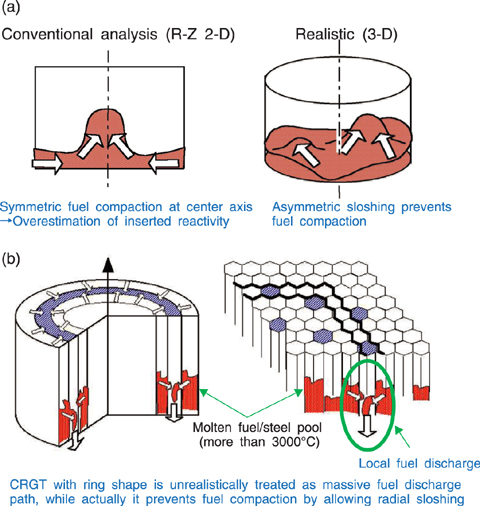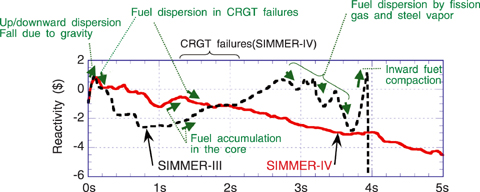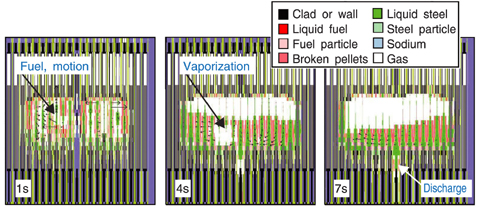
Fig.1-15 Need for a three-dimensional analytical method

Fig.1-16 Comparison of reactivity histories

Fig.1-17 Core material dynamic behavior (SIMMER-IV)
One of the major issues in FBR development is dealing with a core disruptive accident (CDA), which might rapidly release radioactive materials due to its thermal and mechanical consequences, although its occurrence frequency is negligibly low. A high-temperature molten fuel above 3000°C allows forming molten fuel pool, where molten core materials can move between fuel assemblies with molten wrapper tube wall.
A safety analysis code, SIMMER-III, has been utilized for past safety evaluations. This code has been developed in Japan for a multi-phase, multi-component fluid-dynamics model coupled with structural materials models and neutronics models. SIMMER-III, however, is a two-dimensional code. Due to this dimensionality, this code tended to overestimate the reactivity increase resulting from fuel compaction into the core center because it could not simulate motion around the axis (Fig.1-15). Further, the reactivity reduction by fuel discharge through control rod guide tubes (CRGTs) could not be calculated, because the tubes which are dispersed throughout the core could not be simulated. This deficiency has forced the past evaluations to be conservative, since fuel discharge through CRGTs etc. had to be ignored. To reasonably reduce the conservativeness of the evaluation, we have developed the SIMMER-IV code, extending the SIMMER-III framework to three-dimensions. This code clarifies the significance of 3-D simulation by comparing it to the conventional 2-D simulation. In this study, SIMMER-IV has been applied to 3-D simulation of a CDA in an FBR for the first time in the world.
In the SIMMER-III analysis, after output power exceeds the limit for 2.4s, the fuel melts and increases in mobility, and the reactivity reaches prompt criticality in 3.9s due to inward fuel compaction. In the SIMMER-IV analysis, CRGTs failed at different times around 2s cooling the fuel so that it did not become a mobile pool, so that the fuel was not compacted and reactivity did not rise (Fig.1-16). 3-D motion of complex phenomena with phase changes, etc. could be simulated (Fig.1-17).
This study has shown the effectiveness of the 3-D simulation in making reasonable evaluation of accidents.